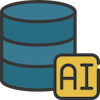 AI Databases
AI Databases
AI databases are a significant evolution in data management
Databases are the backbone of AI systems, storing the enormous amount of data necessary for algorithms to learn, make predictions, and perform tasks. AI databases are specialized data management systems designed to support the specific requirements of AI and machine learning applications. While traditional databases are optimized for transactional workloads, AI databases are engineered to handle the vast and complex datasets needed for training and deploying AI models. They are able to absorb, survey, analyze, and visualize fast-moving, complex data in a matter of milliseconds.
The core function of AI databases is to manage the data lifecycle from ingestion to transformation, storage, and retrieval. They often include advanced features like distributed computing, high-performance querying, and support for various data types and formats. This helps data scientists and AI engineers access the data they need swiftly and efficiently, which in turn enables AI models to experiment and deploy quickly.

 Key Features of AI Databases
Key Features of AI Databases
- Enhanced Performance and Scalability: AI databases are built to manage large-scale data processing tasks, ensuring high performance and scalability. This capability is important for AI and machine language applications where the ability to process vast amounts of data directly impacts model quality and effectiveness.
- Advanced Data Management: They facilitate the entire data lifecycle, from ingestion to transformation, storage, and retrieval, allowing data scientists and AI engineers to access necessary data swiftly.
- Support for Diverse Data Types: AI databases can manage structured, semi-structured, and unstructured data, making them suitable for various applications that require different data formats.
- Vector Storage: A defining feature of many AI databases is their ability to store and process data as high-dimensional vectors, enabling efficient similarity searches essential for tasks like image recognition and natural language processing.
- Automated Data Analysis: These databases excel at automating complex data analysis tasks, quickly identifying patterns and insights within large datasets that would be time-consuming or nearly impossible with traditional systems.
- Integration with Machine Learning: AI databases provide essential functionality for traditional machine learning tasks such as recommendation systems and search engines by efficiently handling similarity computations
 Types of AI Databases
Types of AI Databases
Unlike traditional databases used for decades in computing, AI databases handle large, complex datasets. They store enormous amounts of data of various types and they analyze and retrieve data incredibly fast. Here are some of the major types of databases used in AI:
 AI Vector Databases
AI Vector Databases
Optimized for high-dimensional vector representations, useful in applications like image and speech recognition
AI vector databases are designed to handle high-dimensional vectors representing data in AI applications. These databases are optimized for tasks such as similarity search, where the goal is to find vectors closest to a given query vector. This is highly useful in applications like image and speech recognition, where data is usually represented as high-dimensional vectors. AI vector databases enable efficient storage, indexing, and querying of these vectors, making them a key component of many AI systems. Here is a list of some popular vector databases:
- Chroma: An open-source vector database that builds and serves AI-driven applications with high-performance vector search.
- Faiss: A library developed by Facebook AI for efficient similarity search and clustering of dense vectors and optimized for large-scale data.
- Milvus: An open-source vector database designed for similarity search and managing large-scale unstructured data.
- Pinecone: A managed vector database service designed for fast and scalable similarity search and machine learning applications.
- Qdrant: A vector similarity search engine designed to handle high-dimensional data optimized for performance and accuracy in real-time AI applications.
- Redis: An in-memory data structure store commonly used as a database, cache, and message broker, known for its speed and scalability.
- Vespa: A search engine and data processing platform for real-time, large-scale machine learning models and vector-based retrieval.
- Weaviate: An open-source vector search engine that uses machine learning to store and search data objects by their semantic meaning.
 AI Graph Databases
AI Graph Databases
Designed to manage complex relationships within data using nodes and edges, ideal for social network analysis and recommendation systems
AI graph databases are specialized databases designed to effectively manage complex relationships within data. Unlike traditional relational databases with a row-and-column structure, AI graph databases organize data into nodes and edges, visually representing the connections between entities. This structure provides a more intuitive and efficient way to represent intricate relationships, making it particularly useful in scenarios where understanding connections is important.
These databases are ideal for applications such as social network analysis, fraud detection, and recommendation systems, where it is necessary to understand the relationships between data points. Designed to store and query complex relationships between data entities, graph databases like Amazon Neptune are particularly useful in AI applications that use knowledge graphs, social network analysis, and recommendation systems. Recent research on graph RAG demonstrates their potential to build knowledge graphs from documents for context and generation tasks. Here is a list of some popular graph databases:
- ArangoDB: ArangoDB is a multi-model database that integrates graph, document, and key-value data models. It provides a unified query language optimized for complex data relationships and real-time analytics.
- Azure Cosmos DB: Microsoft's Azure Cosmos DB is a globally distributed, multi-model database service that includes graph database capabilities. It supports various data models and provides low-latency, scalable access to data across different geographic regions.
- Dgraph: Dgraph is a distributed graph database designed for high performance and scalability. It offers a highly efficient querying system and is built to handle massive amounts of data across multiple nodes.
- JanusGraph: JanusGraph is an open-source database that handles large-scale graphs and complex queries. It integrates with big data technologies like Apache Hadoop and Apache Cassandra for scalable and distributed graph processing.
- Neo4j: Neo4j is a leading graph database that efficiently handles complex queries and relationships. It uses a property-graph model to represent and query data, making it ideal for use cases like social networks and recommendation engines.
- OrientDB: OrientDB is a multi-model database supporting graph and document data models. It combines document databases' flexibility with graph databases' power, enabling versatile data management and querying.
- TigerGraph: TigerGraph specializes in real-time, large-scale graph processing and analytics. It is designed to handle complex queries on massive datasets, making it suitable for fraud detection and customer insights applications.
 Relational Databases
Relational Databases
Traditional relational databases that incorporate AI-based extensions to support machine learning algorithms
Relational database systems excel at managing structured data arranged in rows and columns (tables) with predefined formats, making them perfect for precise search operations. Traditional relational databases (RDBMS), such as MySQL and PostgreSQL, use AI-based extensions to incorporate and support machine learning algorithms and deep learning applications to enhance handling structured data. Some relational databases have integrated vector search indexes, like Facebook AI Similarity Search (FAISS), IVFFLAT, or Hierarchical Navigable Small Worlds (HNSW) to enhance their capabilities and simplify vector searches.
 Time-Series Databases
Time-Series Databases
Optimized for managing time-stamped data, commonly used in applications like IoT, finance, and security
These databases are particularly useful in AI applications that need real-time monitoring, predictive maintenance, and anomaly detection. They are designed to efficiently handle large volumes of time-series data and provide fast query performance and scalability. They support advanced time-series analytics to enable users to derive valuable insights from time-stamped data. Open-source databases like InfluxDB and TimescaleDB are optimized to store and analyze large volumes of time-stamped data.
 Document Stores
Document Stores
Manage semi-structured data stored in documents, suitable for applications using diverse data sources
Document stores, also known as document-oriented databases, are designed to manage semi-structured data stored in documents. These databases are highly flexible and can handle various data formats, making them suitable for AI applications that use diverse data sources. Document stores bring high performance and scalability, helping with efficient storage, retrieval, and processing of large volumes of document-based data.
 NoSQL databases optimized for AI
NoSQL databases optimized for AI
The term NoSQL originally referred to "non-SQL" or "non-relational" databases, but the term has since evolved to mean "not only SQL," since NoSQL databases have expanded to include a wide range of different database architectures and data models. NoSQL databases like MongoDB and Apache Cassandra have been optimized to handle large volumes of unstructured or semi-structured data common in AI applications, offering flexible schema designs and high scalability.

 Use Cases for AI Databases
Use Cases for AI Databases
The number of possible uses for AI databases are as large as the number of AI applications. Here are just a few examples:
- Object Detection and Text Analytics: AI databases dramatically enhance object detection and text analytics by efficiently storing and processing large volumes of data to identify patterns and extract information.
- Speech Recognition: AI databases play a crucial role in speech recognition by managing and analyzing large datasets of audio inputs. These databases enable accurate and real-time speech conversion to text.
- Natural Language Processing: AI databases support natural language processing by efficiently managing extensive data for large language models, enabling advanced language understanding and text generation capabilities.
- Social-Network Filtering: AI databases improve social-network filtering by organizing and analyzing user data to detect and block inappropriate content, enhance user experience, and ensure platform safety.
- Visual Inspection: AI databases store and process high-resolution images in visual inspection. This allows automated defect detection and quality control in manufacturing and other industries.
- Supply Chain Optimization: Databases in supply chain management store and process data to forecast demand, optimize inventory levels, and enhance logistics through AI-driven insights.
- Predictive Maintenance: In manufacturing, databases store machine performance data, which AI uses to predict equipment failures, reducing downtime and maintenance costs.
- Educational Tools and Learning Systems: AI in education uses databases to track student performance and learning patterns. This data helps in personalizing educational content and identifying areas needing improvement.
- Traffic and Urban Planning: Databases are used to store traffic flow and urban layout data. AI analyzes this data for urban planning, optimizing traffic patterns, and reducing congestion. This can even be used to plan routes for autonomous vehicles.
 AI Tools for Database Design
AI Tools for Database Design
For those searching for AI tools to use in database applications, the following AI database design tools are worth a look. The software tools optimize complex queries, manage architectures, and provide dynamic, customizable, and easily editable solutions. These tools are useful for creating quality database management systems of virtually any size.
PostgreSQL
PostgreSQL is a machine learning extension for PostgreSQL databases. It performs various Natural Language Processing (NLP) tasks such as question answering, summarization, translation, sentiment analysis, and text generation using simple SQL queries. It integrates with HuggingFace and supports libraries like Scikit-learn, XGBoost, LGBM, PyTorch, and TensorFlow.
MongoDB Atlas
MongoDB Atlas AI enables the development of AI-enriched applications for purposes like fraud prevention, predictive maintenance, and personalization. It is a fully managed cloud database service with native vector capabilities and document data stores. It harnesses the power of Atlas vector search and allows the creation of applications.
SuperDuperDB
SuperDuperDB is a Python framework that integrates AI models and APIs with existing databases. It supports SQL databases and offers features like real-time inference and scalable model training. It transforms databases into intelligent platforms by enabling vector search and streamlined inference.
Towhee
Towhee is an open-source AI-powered framework that excels in handling unstructured data. It provides ETL (Extract, Transform, Load) capabilities and uses generative AI and deep learning tools to automate and optimize data transformation. It converts unstructured data like images, audio, and text into structured formats.
Airtable AI
Airtable AI automates complex tasks and analyzes large datasets to provide predictive insights. It enhances database management and operations by organizing performance data and taking customer feedback. It can tag and organize information, translate content, and provide summarization and insight extraction.
Redis AI
Redis AI is a module for the Redis database that provides a platform for machine learning and deep learning models. It offers high performance in real-time analytics and supports frameworks like TensorFlow, PyTorch, and ONNX. It handles multiple requests efficiently and maintains high stability.
Taskade AI
Taskade AI offers an AI Database Design Flowchart Generator that visualizes complex data relationships using flowcharts. It generates and publishes flowcharts, streamlining database design and enhancing overall stability. It minimizes errors and redundancies, making it a comprehensive tool for database design.
Workik AI
Workik AI provides a collaborative environment for database schema design. It uses AI to simplify the design process and provides documentation for SQL and NoSQL databases. It offers custom schema optimization, anomaly detection, and in-depth schema documentation.
Lucidchart
Lucidchart is a versatile AI tool that enhances productivity and clarity in database design. It allows teams to collaborate effectively and align data structures. It imports database structures directly from the database management system and visualizes them as Entity Relationship Diagrams (ERD).
 Challenges in AI databases
Challenges in AI databases
The benefits of AI databases are substantial, but organizations may face several challenges during adoption. By addressing these challenges, businesses can successfully integrate AI databases into their operations.
Privacy, security, and compliance
Data privacy and security is a primary adoption challenge. As these systems handle large volumes of sensitive information, organizations must implement safeguards to protect against breaches and unauthorized access. This is accomplished by ensuring the highest standard of encryption protocols for data at rest and in transit, assessing security audit and vulnerabilities regularly, and verifying proper compliance with data protection regulations such as the GDPR and AI Act.
Specialized skills
AI databases aren't plug-and-play; they require generative AI knowledge, machine learning expertise, and data science skills. That's a challenge for organizations with limited resources in this area. AI databases require high-quality, well-prepared data to function effectively. Organizations may need to invest significant resources in cleaning, normalization, and enriching messy tabular data or generate synthetic data to ensure accurate insights are delivered. Partnering with businesses that offer specialized services in this domain can help solve this problem.
Legacy integration
Integrating AI databases with legacy systems and workflows can be complex and potentially disruptive. A phased integration plan with proper APIs and middleware development smooths this transition and boosts overall data pipeline efficiency.
 Benefits of AI Databases
Benefits of AI Databases
AI databases are built to handle large-scale data processing tasks, which are expected in AI and ML applications. They promise high performance and scalability, enabling entities to manage and analyze enormous datasets without affecting speed or accuracy. This is particularly important for AI ML training databases, where the ability to process and learn from vast amounts of data directly impacts the quality and effectiveness of the AI models.
Advanced Data Management
These databases provide sophisticated data management capabilities, such as support for many data types, including text, images, and unstructured data. AI vector databases, for instance, were created to manage high-dimensional vectors used in various AI applications like image recognition and natural language processing. This advanced data management ensures that all relevant data can be effectively utilized, regardless of its format or complexity.
Improved Data Integration
AI databases often come with built-in tools for seamless integration with alternative data sources and systems. This is key for creating comprehensive datasets that encompass all the relevant information. AI and graph databases excel at managing and querying interconnected data, making them ideal for applications that require understanding relationships and patterns within the data.
Accelerated AI Development
By providing a robust data storage and processing infrastructure, AI databases accelerate the AI development process. They help data scientists focus on model development and experimentation instead of spending time on data wrangling and management; this streamlined workflow results in faster iteration cycles and deployment of AI solutions.
 FAQs
FAQs
What is a database?
A database is an organized collection of structured information or data, typically stored electronically in a computer system. It is usually controlled by a database management system (DBMS), which serves as an interface between the database and its end users or programs, allowing users to retrieve, update, and manage the data efficiently.
What is an AI Database?
An AI database is a specialized data storage and management system designed to support AI models, querying, and machine learning applications. AI databases optimize resources for an organization and provide data analysis and visualization in milliseconds.
What is the difference between RDBMS and DBMS?
In a DBMS, the data is stored as a file, whereas in an RDBMS, data is stored in the form of relational tables; that is, tables that are relelated by some key or index.
Which database is used for AI?
AI often uses databases like MongoDB, Cassandra, and HBase to process data. They offer the scalability and flexibility needed for large volumes of data .
Do you need a database for AI?
Yes, databases store the vast amounts of data that feed into AI algorithms used to make accurate predictions or decisions.
Is SQL or NoSQL better for machine learning?
NoSQL can be more suitable because it handles unstructured data well, which supports structured data common in machine learning scenarios.
Can you use Oracle for AI and machine learning?
Yes, Oracle offers built-in support for machine learning with its Advanced Analytics option, integrating R language capabilities into SQL queries.
What is the advantage of using Apache Cassandra?
The data in it replicates itself to various nodes for fault tolerance, and the design of this database is for both read and write throughput.
 Links
Links
gigaspaces.com/data-terms/ai-databases
datastax.com/guides/ai-database
techaheadcorp.com/blog/top-databases-machine-learning-ai/
clickworker.com/customer-blog/databases-for-machine-learning/
pcmag.com/news/ai-databases-what-they-are-and-why-your-business-should-care